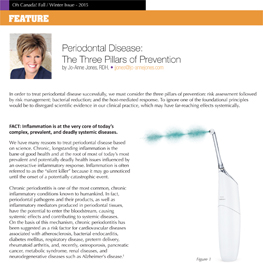In order to treat periodontal disease successfully, we must consider the three pillars of prevention: risk assessment followed by risk management; bacterial reduction; and the host-mediated response. To ignore one of the foundational principles would be to disregard scientific evidence in our clinical practice, which may have far-reaching effects systemically.
FACT: Inflammation is at the very core of today’s complex, prevalent, and deadly systemic diseases.
We have many reasons to treat periodontal disease based on science. Chronic, longstanding inflammation is the bane of good health and at the root of most of today’s most prevalent and potentially deadly health issues influenced by an overactive inflammatory response. Inflammation is often referred to as the “silent killer” because it may go unnoticed until the onset of a potentially catastrophic event.
Chronic periodontitis is one of the most common, chronic inflammatory conditions known to humankind. In fact, periodontal pathogens and their products, as well as inflammatory mediators produced in periodontal tissues,
have the potential to enter the bloodstream, causing systemic effects and contributing to systemic diseases. On the basis of this mechanism, chronic periodontitis has been suggested as a risk factor for cardiovascular diseases
associated with atherosclerosis, bacterial endocarditis, diabetes mellitus, respiratory disease, preterm delivery, rheumatoid arthritis, and, recently, osteoporosis, pancreatic cancer, metabolic syndrome, renal diseases, and neurodegenerative diseases such as Alzheimer’s disease.1
The Canadian Dental Hygienists Association (CDHA) has recently released an evidence-based fact sheet entitled, “Talking Points: Whole Body Health Requires Oral Health.” The document examines the connection between oral inflammation and the respiratory system, the endocrine system (namely diabetes), the cardiovascular system, the reproductive system, growth and development, and the side effects of certain therapies such as radiation and
chemotherapy. The fact sheet may be given to clients, providing elevated understanding of the many reasons why oral health is a strong contributor to overall health.2
In order to treat periodontal disease successfully, we must consider the three pillars of prevention: risk assessment followed by risk management; bacterial reduction; and the host-mediated response. To ignore one of the foundational principles would be to disregard scientific evidence in our clinical practice, which may have far-reaching effects systemically.
FACT: Risk assessment and subsequent risk management is critical to the success of treatment outcomes.
Treating periodontal disease has the potential to improve a client’s risk profile for development and continuation of a number of health concerns. Identifying modifiable risk factors provides an opportunity to empower our clients to take responsibility and exert greater control over treatment outcomes.
You can read the full article now or save it to read late by clicking and saving the PDF below.
Acknowledgements: Article from Oh Canada! CDHA - Fall/Winter 2015. Used with permission from Canadian Dental Hygienists Association.











